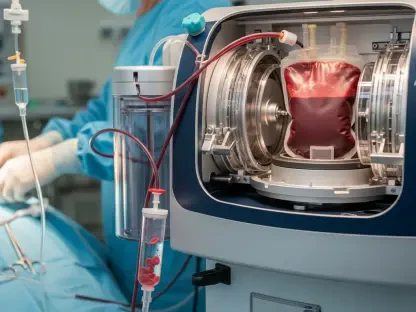What happens when a devastating blood cancer like acute myeloid leukemia (AML) meets a breakthrough that could alter its deadly course for thousands of patients, offering a glimmer of hope in a landscape often marked by despair? In a field where relapsed or refractory AML frequently leaves little room for optimism, Kura Oncology’s newly approved drug, Komzifti, emerges as a beacon of possibility. Approved by the FDA for adults with the NPM1 mutation, this once-daily oral therapy is not just a treatment—it’s a potential lifeline for those who have exhausted other options. The arrival of Komzifti sparks curiosity about how targeted therapies are reshaping the fight against one of the most aggressive cancers known to medicine.
A New Hope for AML Patients: Unveiling Komzifti’s Breakthrough
The journey to finding effective treatments for AML has long been fraught with challenges, particularly for the 30% of patients carrying the NPM1 mutation, a genetic marker linked to poor outcomes when the disease relapses. Komzifti, Kura Oncology’s first commercial product, steps into this void with a promise of change. Its FDA approval marks a pivotal moment, offering a targeted option where few existed before and igniting a competitive spark in the realm of precision oncology.
This milestone isn’t just about a new drug entering the market; it represents a shift toward personalized medicine, where treatments are tailored to specific genetic profiles. For patients who have battled through rounds of failed therapies, the introduction of Komzifti brings a renewed chance at remission, even if only for a subset of this complex disease. The buzz surrounding its launch hints at broader implications for how AML care could evolve in the coming years.
Why Komzifti Matters in the Fight Against AML
AML strikes with ruthless speed, often leaving patients and families grappling with a diagnosis that offers limited paths forward, especially after initial treatments fail. The disease’s aggressive nature means that relapsed or refractory cases carry a grim prognosis, with many patients facing a lack of viable solutions. Komzifti’s focus on the NPM1 mutation addresses a critical gap, targeting a significant portion of AML cases with a therapy designed for their unique genetic makeup.
Beyond the clinical impact, this development resonates on a deeply human level. For those affected by AML, the approval of a new drug symbolizes more than just another option—it’s a glimmer of possibility amidst uncertainty. As precision medicine gains traction in oncology, Komzifti stands as a testament to the potential of science to tackle even the most daunting health challenges, offering a narrative of resilience for patients and caregivers alike.
Unpacking Komzifti: Mechanism, Efficacy, and Competitive Edge
At the heart of Komzifti’s innovation is its unique mechanism of action, targeting the menin-KMT2A interaction that fuels AML progression in NPM1-mutant cases. Unlike therapies that directly attack the mutation, this oral drug, taken once daily, disrupts a key pathway responsible for the uncontrolled growth of immature white blood cells. This indirect approach showcases a sophisticated strategy in curbing the disease’s advance, tailored to a specific subset of patients.
Clinical trials further underline its potential, with a Phase 2 study of 112 patients revealing that 21.4% achieved complete remission or partial hematological recovery. Notably, 88% of responders saw results within six months, a meaningful outcome for individuals with no other recourse. While the response rate may seem modest, it represents a crucial step forward for those in desperate need of alternatives, highlighting the drug’s niche but vital role.
When compared to Syndax Pharmaceuticals’ Revuforj, the first approved menin inhibitor, Komzifti holds distinct advantages. Its once-daily dosing contrasts with Revuforj’s twice-daily schedule, potentially easing adherence for patients. Additionally, Komzifti’s safety profile avoids the severe cardiac risk warnings and drug interaction concerns tied to its competitor, positioning it as a more manageable option in complex treatment plans.
Expert Insights and Real-World Implications
Voices from the medical field are amplifying Komzifti’s significance, with experts pointing to its practical benefits in clinical settings. Dr. Eunice Wang, chief of leukemia service at Roswell Park Comprehensive Cancer Center and a key investigator in the drug’s trials, has noted, “The absence of severe cardiac warnings and drug-drug interactions offers a substantial clinical advantage.” This feedback suggests that physicians may favor Komzifti for patients managing multiple medications, a common scenario in AML care.
The drug’s market rollout also paints a picture of confidence, with a price tag of $48,500 per month and projected annual sales of $350 million to $400 million in the relapsed setting. Kura Oncology envisions even greater potential, estimating up to $7 billion in revenue if Komzifti expands to first-line treatment. Upcoming data at the American Society of Hematology meeting is expected to shed light on these ambitions, potentially reshaping its trajectory in the oncology market.
These insights reflect not just the drug’s immediate impact but also its broader influence on treatment paradigms. For healthcare providers, Komzifti’s cleaner safety profile and high market expectations signal a shift in how AML therapies are prioritized, especially for genetically defined patient groups. This evolving landscape underscores the importance of staying attuned to emerging research and real-world outcomes.
Navigating the Future: Practical Steps for Patients and Providers
For those directly affected by AML, integrating Komzifti into treatment plans requires a clear understanding of eligibility and access. Patients should work with oncologists to confirm the presence of the NPM1 mutation through genetic testing, as the drug is specifically approved for this group in relapsed or refractory stages. This step ensures that the therapy aligns with individual medical needs, maximizing its potential impact.
Beyond eligibility, discussions around treatment fit are essential, weighing Komzifti’s once-daily convenience and safety advantages against alternatives like Revuforj. This is particularly relevant for individuals with heart health concerns or those on multiple drugs, where minimizing interactions becomes a priority. Engaging in these conversations with healthcare teams can help tailor decisions to specific circumstances.
Access and affordability remain key hurdles, given the drug’s steep cost. Exploring Kura Oncology’s patient support programs or coordinating with insurance providers can ease financial burdens as Komzifti becomes available in the U.S. market. Staying informed about ongoing studies, especially regarding combination therapies or expanded uses, also empowers patients and providers to anticipate future options in AML management.
Looking back, the approval of Komzifti stood as a turning point, offering a targeted lifeline to AML patients with the NPM1 mutation who had few alternatives. Its clinical results, competitive advantages, and market potential had redefined possibilities in a field long marked by despair. Moving forward, stakeholders were encouraged to prioritize genetic testing to identify eligible candidates, advocate for broader access through support initiatives, and monitor evolving research for combination approaches. The hope was that such efforts would continue to build on this breakthrough, paving the way for even more transformative strides in AML care.









